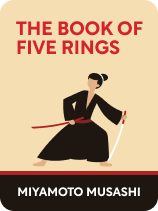

This article is an excerpt from the Shortform book guide to "The Book of Five Rings" by Miyamoto Musashi. Shortform has the world's best summaries and analyses of books you should be reading.
Like this article? Sign up for a free trial here .
Are you looking for The Book of Five Rings review? What can you learn from reading Miyamoto Musashi’s book?
Two years before his death, the famous Samurai Miyamoto Musashi (1584-1645) retired from dueling and retreated to a cave to write and reflect upon the true Way of the warrior. The resulting book, The Book of Five Rings, contains the key principles of Musashi’s philosophy.
Here’s our review of The Book of Five Rings, including a discussion of its historical context and impact.
About the Author
Miyamoto Musashi was born in the Harima Province of Japan in 1584, the son of a swordsman. Musashi fought and won his first duel at age 13. At age 16 he embarked on his personal musha shugyō, the traditional rite-of-passage for Samurai in which the aspiring warrior traveled throughout Japan, fighting duels and learning more about his craft. Afterward, Musashi took up residence at a Buddhist temple while continuing to hone his skills in swordsmanship. In 1612, Musashi fought one of his most famous duels against another leading Samurai, Sasaki Kojirō, whom he killed.
In later years, Musashi ran his own school for training aspiring Samurai. A couple of years before his death, Musashi recorded his key principles of swordsmanship in his Book of Five Rings. He also later completed a short book called The Way of Walking Alone. Apart from his legendary status as a swordsman, Musashi was also known as an accomplished calligrapher and painter. He died in 1645, after having spent his final years mostly in seclusion. In the centuries since his death, Musashi’s life has inspired numerous films, novels, and television series—a testament to his lasting impact in Japanese popular culture.
The Book’s Publication
The Book of Five Rings was written in Japanese around 1643, and it now exists in multiple modern English translations. Due to the book’s linguistic and historical challenges, producing a definitive translation can be tricky. Musashi’s writing style can be vague even at the best of times; the fact he is writing in centuries-old Japanese about a martial arts tradition deeply embedded in his 17th-century culture adds to the possible difficulties of interpretation.
The first mainstream English publication featured a translation by Victor Harris and was published by Overlook Press in 1974. The book was marketed as particularly useful for businessmen seeking to understand strategy in a modern competitive context. A later translation by Thomas Cleary sought to contextualize Musashi’s thinking within its spiritual and historical context. Cleary’s interest in the culture of the Samurai is also displayed in his translation of a book of strategy by another Samurai, Taira Shigesuke, and his numerous translations of other works related to martial arts.
Our guide uses the Kindle edition of the translation by William Scott Wilson. Wilson’s translation is fairly terse and functional, and it seems to aim for clarity over style.
Historical Context
The Samurai were an elite caste of warriors in Japan with a military tradition that endured for several centuries. The Samurai first came to prominence during the Kamakura Period (1185-1333) and lasted until their official dissolution in 1879, when Japan began to favor modernization in its military. Although trained as warriors, many prominent Samurai dynasties also became involved in politics, with members of Samurai clans holding important civil positions within the Imperial government.
The values of the Samurai were largely influenced by different strains of Eastern philosophy, such as Buddhism and Confucianism. The ideal Samurai had to be brave, calm, highly skilled with his weapons, and fiercely loyal to his Lord or Emperor. A true Samurai who had failed in combat or behaved dishonorably would commit seppuku, a ritual suicide. Oftentimes, shortly before the seppuku, the Samurai would compose a short “death poem” as a formal leave-taking of the world.
While no longer an active force in the modern world, the Samurai remain historically and culturally important in the Japanese popular consciousness. There are many novels, films, and other forms of media inspired by the Samurai, and the traditional art of swordsmanship is still practiced today in some martial arts schools.
Samurai Manuals of Instruction
Although perhaps the most famous Samurai of his day, Musashi is not the only Samurai to have left behind a written account of his strategies. Some other famous Samurai whose works have been translated into English include Taira Shigesuke, Yamamoto Kansuke, and Natori-Ry. When Musashi discusses rival schools of instruction in the Book of Wind, a chapter in The Book of Five Rings, it is important to keep his contemporary context in mind: Musashi was not the only Samurai offering an interpretation of the Way, and opinions did differ in terms of approach and technique among different Samurai. In assessing these rival schools and offering his own strategies for aspiring warriors, Musashi was contributing to important debates and rivalries active in his time.
Musashi left another text before his death, The Way of Walking Alone, which is a meditation on self-reliance. It contains 21 general principles that Musashi believes are key to having a successful and peaceful life.
The Tradition of Manuals of Instruction
Manuals of instruction have long existed as a genre in both the West and East, and they can address an almost limitless number of topics. As noted above, many manuals of instruction by other Samurai exist. Within a broader Eastern historical context, the Chinese The Art of War by Sun Tzu is a useful point of comparison to The Book of Five Rings. It is an earlier example (5th century AD) of strategy offered for forms of combat. However, Tzu focuses on strategies for armies, as opposed to focusing on individual combat as Musashi tends to do.
Within the Western tradition, a manual of instruction that exhibits a similar sort of spirit to The Book of Five Rings is Niccolò Machiavelli’s The Prince, which was written in around 1510 and first published in 1532—approximately a century before The Book of Five Rings was written. While Musashi seeks to create the perfect warrior, Machiavelli offers advice for becoming the perfect politician. Like Musashi, Machiavelli is not concerned with conventional morality—an aspect of The Prince that has become somewhat infamous, both during Machiavelli’s own time and in the centuries since. What Musashi and Machiavelli share in common above all else is a total commitment to victory: Both writers argue that a man must be ruthlessly disciplined in achieving his goal and willing to succeed at any cost.
The Book’s Impact
The Book of Five Rings has found popularity outside of martial arts contexts in two general respects: as a guide to strategy that can be applied to a modern business context, and as principles that can be applied to an individual’s personal goals or interests more generally.
Application to Business
As mentioned above, when an English translation of The Book of Five Rings first appeared in 1974, it was marketed as a guide for businesspeople. This helped to popularize the book with Western readers, especially in the wake of Japan’s economic boom in the 1980s. Nowadays, the book’s relevance for modern business is sometimes questioned by some readers and commentators; however, this guide notes principles that may be useful for a reader’s professional life.
Application to Personal Interest and Well-Being
The Book of Five Rings has also attracted interest from readers seeking a “self-help” guide to becoming more disciplined or successful. Musashi’s principles about training the body and mind to be in sync, his encouragement of focus and discipline, and paying attention to detail are some of the strategies such readers will find of value.
Critical Reception
Musashi remains alive and well in the popular consciousness in Japan, and several studies about his life have also appeared in English in recent years (see our “further reading” list at the end of this guide for some biographical sources).
However, in spite of its historical and cultural significance, The Book of Five Rings has some potential obstacles for the modern reader. Some The Book of Five Rings reviews complain about Musashi’s habitual vagueness, arguing that it is difficult to discern Musashi’s principles—or to apply them—since he rarely offers explicit guidance. Others argue that the book is limited to its historical or martial arts value, as they struggle to see any meaningful connection to modern contexts. Some readers mention feeling uncomfortable with Musashi’s lack of interest in ethics, reflected in his dispassionate killing of opponents.
The difficulties of Japanese-to-English translation and the vagueness and disorganization of the text present many challenges, especially for the more casual reader. As noted, Musashi’s indifference to moral issues—and his wholehearted embrace of the violence inherent to the Samurai lifestyle—means that the Book of Five Rings lacks a well-developed ethical or philosophical side. Even the more Zen-like meditation in the fifth book, the Book of the Void, is included by Musashi only because he believes “the Void” is the key to being a successful warrior, not because he aspires to Buddhism’s traditional renunciation of violence.
Commentary on the Book’s Approach
Although The Book of Five Rings is technically a manual of instruction, it doesn’t necessarily instruct the reader especially well—or at least, not in the way a modern reader might expect it to. While reading the book, it is important to keep the following key factors in mind:
- Musashi advocates a student-centric approach to learning. Musashi describes the teacher as a needle and the student as a thread: The teacher facilitates learning by providing general instruction, but it is up to the student to take charge of his learning and apply it to his own life. Musashi frequently exhorts his reader to read carefully and slowly in order to understand the true meaning of his words and to take ownership of his own training—as he states, it is up to each aspiring warrior to find the Way in his own right. Learning is active, not passive.
- Musashi believes many things can’t be explained in writing. Musashi makes things even more challenging for his reader by frequently admitting that he can’t always clearly define or explain what he means. Because of this, much of what Musashi writes about is left vague or open-ended; the reader needs to actively interpret Musashi’s principles for himself, and find ways of putting the principles into practice.
- Musashi advocates mastering each principle before moving on to the next one. In terms of using his manual, Musashi consistently offers only two pieces of advice: to meditate carefully upon his words and to move on to a new principle only once you have thoroughly absorbed the former principle. But Musashi doesn’t say how much time is long enough for absorbing each principle or how the reader will know when he is ready to move on to a new principle. Because of this, it is once again left up to the individual reader to judge when they are ready.
Commentary on the Book’s Organization
The Book of Five Rings is divided into five chapters or “books,” named after the five core elements in Buddhism: ground, water, fire, wind, and “the Void.” Musashi doesn’t explain his use of “rings” in the work’s title, although the “five rings” appear to be synonymous with the five books, and could refer metaphorically to the five main areas of Japanese swordsmanship.
Sometimes the link between a book’s element and its subject matter isn’t fully apparent:
- The Ground Book. The element of the first book is earth, because like the earth, the book serves as the foundation for all of Musashi’s strategies.
- The Water Book. Musashi argues that the true warrior must be like water. Water can change its form (liquid, solid, gas) and can take the shape of any container it is poured into. Likewise, the warrior must be adaptable and flexible.
- The Fire Book. The third book deals with combat, both against individuals and against armies. Like different forms of combat, a fire can be large or small. Its power and intensity mirror the power and intensity of the true warrior.
- The Wind Book. Musashi critiques some of the rival Samurai schools of his own day in the fourth book. Musashi claims that, for him, “wind” represents tradition, although he doesn’t explicitly define why tradition is like wind.
- The Book of the Void. While “the Void” is not a recognized natural element in most forms of Western thought, it is an important concept in Zen Buddhism. The Void is a state of emptiness in which mind and body become one and achieve perfect tranquility. Musashi believes that the true warrior gains access to the Void if he follows the Way.
Musashi’s general organizational approach in The Book of Five Rings can be a little confusing for readers familiar with other manuals of instruction, both historical and modern. Although a short book, the text is quite dense, and it isn’t always intuitive in its structure. This lack of clear, linear organization can make the thread of Musashi’s thought hard to follow. Musashi himself admits that his book is disorganized: For this reason, distinguishing main principles from sub-principles—or the ideal order in which the warrior should study these principles—is not clearly laid out. Furthermore, Musashi doesn’t usually give specific guidance when it comes to applying his principles—there are no handy step-by-step instructions to illustrate each principle before moving on to the next one.

———End of Preview———
Like what you just read? Read the rest of the world's best book summary and analysis of Miyamoto Musashi's "The Book of Five Rings" at Shortform .
Here's what you'll find in our full The Book of Five Rings summary :
- Insights from the famous Samurai Miyamoto Musashi about the Way of the Warrior
- How to apply Musashi’s teachings to your personal and professional lives
- Why success is not based on brute strength or innate talent






